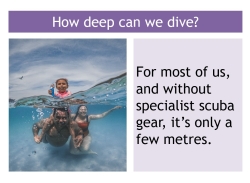Pressure in fluids

This engaging GCSE physics resource includes a presentation on fluid pressure with four varied tasks, including practical demonstrations to show that pressure increases as depth increases.
The PowerPoint begins by asking students to consider why divers can’t dive very deep. It then explains how pressure acts in a fluid, with a diagram to show the collisions and the forces at right angles. Using worked examples, it recaps the equation pressure = force/area and introduces the equation pressure = column height x density of the liquid x gravitational field strength (or p = hpg). The factors affecting floating and sinking are demonstrated, and the concept of upthrust is explained.
Students then carry out two simple experiments using polystyrene or paper cups to demonstrate that pressure increases with the height of the column of liquid above that point.
To consolidate their learning, they can play the checkerboard challenge, rolling a dice to determine which challenge they undertake (drawing sketches or diagrams, rearranging pressure equations, explaining real-world phenomena or creating fact sheets). There is also a ‘spot the mistakes’ activity that would be useful as a plenary.
One of the worked examples on calculating pressure:
Calculate the pressure on a fish swimming at a depth of 8 m. The density of the water is 997 kg/m3. Assume the value of g to be 9.8 N/kg.
p = h ρ g
= 8 m × 997 kg/m3 × 9.8 N/kg
= 78.2 × 103 Pa
